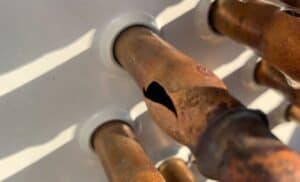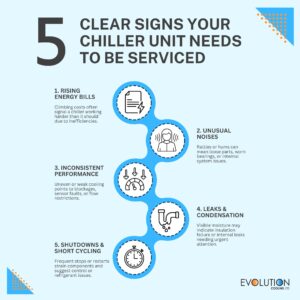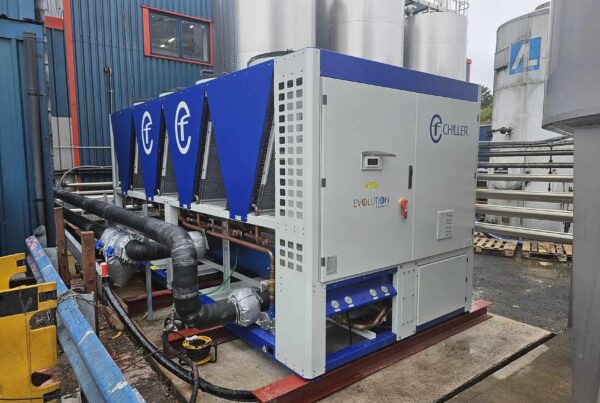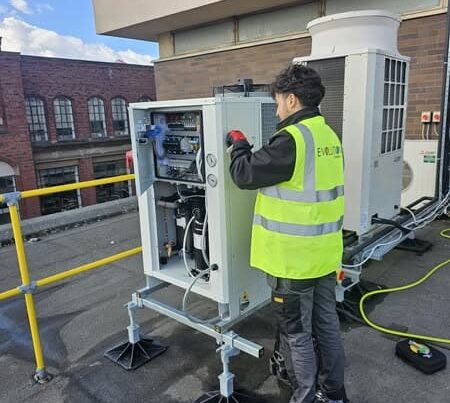Most chiller failures do not happen out of nowhere. In many cases, systems will show clear warning signs that something is wrong. These may seem minor at first but can quickly lead to reduced efficiency, increased running costs or even a complete system breakdown if ignored.
Routine chiller servicing is the best way to keep your system running reliably. Therefore, if you notice any of the following signs, it may well be time to have your chiller professionally inspected and maintained by a qualified engineer.
1. Rising Energy Bills with No Obvious Cause
A slow but steady increase in energy bills can be one of the first signs of an underperforming chiller. Given energy price hikes in recent years, it is best to check on the amount of electricity your business is consuming. If your energy usage is climbing despite stable production levels or footfall, the system may be working harder than it should to achieve the same output.
Common causes include dirty condenser coils, a drop in refrigerant charge or inefficiencies in heat transfer. Even control faults or incorrect sensor readings can make a system run longer than necessary, leading to increased energy use without delivering any benefit.
For example, a retail site running multiple rooftop chillers may see a 10 to 15% increase in cooling costs if airflow is restricted or refrigerant levels are low. A scheduled service visit can identify the issue early on. Simply by cleaning and recalibrating the affected components, it is often possible to restore system efficiency and bring down energy expenditure accordingly.
2. Unusual Noises from the Chiller or Piping

Unusual sounds should never be ignored with chiller units. Rattling, clanging, buzzing or humming noises may suggest a diverse array of problems. Such sounds can be caused by worn bearings, loose components or vibration from unbalanced fans or motors, for example.
There again, if these noises are coming from within the pipework, it could indicate pump cavitation, air pockets or pressure fluctuations. These can lead to damage over time and reduce the overall lifespan of the system. Either way, you should deal with noisy chillers before the issue worsens.
Bear in mind, too, that in customer-facing environments such as gyms or hotels, noise complaints can also affect user experience. Early servicing can identify the source of the noise and prevent more serious issues from developing. Engineers can check mounts, replace failing parts and make any necessary alignment or balance adjustments.
3. Inconsistent or Poor Cooling Performance

If your company’s chiller is failing to maintain target temperatures or cooling is uneven across zones, then it is another clear sign that servicing is needed. These issues are often caused by restricted water flow, blocked strainers, fouled evaporators or sensor faults.
For critical operations such as food manufacturing or climate-controlled storage, even slight temperature fluctuations can result in spoilage or safety concerns. The same applies to IT and data centres, where cooling reliability is non-negotiable, something that could affect the entire business’s operations.
In most cases, a service technician will be able to trace the problem to one or two key areas. Addressing the needs of heat exchangers, verifying flow rates and testing sensors can often restore stable, consistent performance before the system reaches a point of failure.
4. Leaks or Excessive Condensation Around the Unit

Pooled water or visible leaks around the chiller are often overlooked, but they should be taken seriously. Common causes include blocked or disconnected condensate drain lines, failed insulation or leaks from internal pipework or pump seals but there are other, less common causes, too, that aren’t so easy to spot.
Over time, excess moisture can contribute to rust, damage nearby equipment or create slip hazards around plant areas. When it comes to indoor installations, such as plant rooms in leisure centres or hospitals, water damage can spread quickly if not addressed.
Regular maintenance includes checking all drains and pump operation, inspecting for signs of insulation breakdown and ensuring that all pipework is properly sealed. Catching small leaks early is far easier and less expensive than waiting for a failure that could lead to downtime, the need to install new chiller units or damage to surrounding property.
5. Frequent Shutdowns or Short-Cycling
If the chiller is starting up and shutting down repeatedly or if it occasionally powers down without warning, there may be an underlying issue with controls or mechanical operation. Known as short-cycling, this behaviour is extremely hard on compressors and often reduces system life.
Common causes include faulty pressure sensors, incorrect setpoints, low refrigerant or software issues in the control panel. Sometimes, a poorly sized system or incorrect control logic can also be to blame, especially in older installations.
Frequent shutdowns are inconvenient, typically requiring a 24/7 breakdown repair. They lead to temperature instability, increased wear on components and a higher likelihood of emergency repairs. A trained technician can run diagnostics, review the control settings and test electrical and pressure systems to identify the root cause.
If you have noticed one or more of these signs, then it is best not to wait until a complete failure occurs. Contact Evolution Cooling to schedule a professional service visit and keep your system running at its best.






